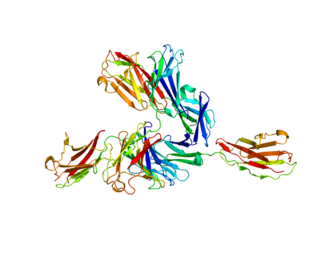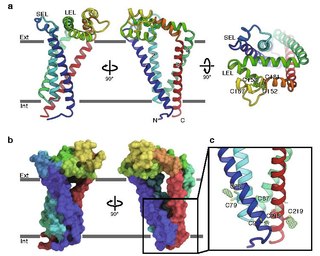CD63 antigen is a protein that, in humans, is encoded by the CD63 gene. [5] CD63 is mainly associated with membranes of intracellular vesicles, although cell surface expression may be induced.
CD63 antigen is a protein that, in humans, is encoded by the CD63 gene. [5] CD63 is mainly associated with membranes of intracellular vesicles, although cell surface expression may be induced.
The protein encoded by this gene is a member of the transmembrane 4 superfamily, also known as the tetraspanin family. Most of these members are cell-surface proteins that are characterized by the presence of four hydrophobic domains. The proteins mediate signal transduction events that play a role in the regulation of cell development, activation, growth, and motility. This encoded protein is a cell surface glycoprotein that is known to complex with integrins. It may function as a blood platelet activation marker. Deficiency of this protein is associated with Hermansky-Pudlak Syndrome . Also this gene has been associated with tumor progression. The use of alternate polyadenylation sites has been found for this gene. Alternative splicing results in multiple transcript variants encoding different proteins. [5]
CD63 is a good marker for flow cytometric quantification of in vitro activated basophils for diagnosis of IgE-mediated allergy. The test is commonly designated as basophil activation test (BAT).
Initially, deletion and point mutants were used to investigate the role of the C-terminus, which contains a putative lysosomal-targeting/internalisation motif (GYEVM). C-terminal mutants showed increased surface expression and decreased intracellular localisation relative to CD63Wt. Antibody induced internalisation was reduced in C-terminal deletion mutants and abolished in G→A and Y→A mutants, showing the crucial role of these residues in internalisation.
CD63 is extensively and variably glycosylated and the EC2 region contain three potential N-linked glycosylation sites (N130, N150, and N172). Mutants N130A and N150A were similar to hCD63Wt with respect to intracellular localisation and internalisation. However, the hCD63N172A mutant showed a mainly cell surface localisation and low internalisation. Expression of a mutant lacking all three glycosylation sites was very unstable. It was speculated that the reduced internalisation of CD63N172A might be due to changes in its interaction with cell surface molecules. Immunoprecipitation experiments showed some evidence of a protein (100kDa) associating with CD63N172A, but this was not consistent. However, an association between CD63Wt and β2 integrin (CD18) was shown by co-internalisation of these proteins. Interactions with CD63 may therefore affect the trafficking and function of β2 integrins.
In cell biology, CD63 is often used as a marker for multivesicular bodies, which in some cells are enriched with CD63, [6] as well as for extracellular vesicles released from either the multivesicular body or the plasma membrane. [7]
CD63 has been shown to interact with CD117 [8] and CD82. [9]

Basigin (BSG) also known as extracellular matrix metalloproteinase inducer (EMMPRIN) or cluster of differentiation 147 (CD147) is a protein that in humans is encoded by the BSG gene. This protein is a determinant for the Ok blood group system. There are three known antigens in the Ok system; the most common being Oka, OK2 and OK3. Basigin has been shown to be an essential receptor on red blood cells for the human malaria parasite, Plasmodium falciparum. The common isoform of basigin (basigin-2) has two immunoglobulin domains, and the extended form basigin-1 has three.

Integrin beta-1 (ITGB1), also known as CD29, is a cell surface receptor that in humans is encoded by the ITGB1 gene. This integrin associates with integrin alpha 1 and integrin alpha 2 to form integrin complexes which function as collagen receptors. It also forms dimers with integrin alpha 3 to form integrin receptors for netrin 1 and reelin. These and other integrin beta 1 complexes have been historically known as very late activation (VLA) antigens.

CD49d is an integrin alpha subunit. It makes up half of the α4β1 lymphocyte homing receptor.

Integrin alpha-3 is a protein that in humans is encoded by the ITGA3 gene. ITGA3 is an integrin alpha subunit. Together with beta-1 subunit, it makes up half of the α3β1 integrin duplex that plays a role in neural migration and corticogenesis, acted upon by such factors as netrin-1 and reelin.

CD9 is a gene encoding a protein that is a member of the transmembrane 4 superfamily also known as the tetraspanin family. It is a cell surface glycoprotein that consists of four transmembrane regions and has two extracellular loops that contain disulfide bonds which are conserved throughout the tetraspanin family. Also containing distinct palmitoylation sites that allows CD9 to interact with lipids and other proteins.

Leukocyte antigen CD37 is a protein that in humans is encoded by the CD37 gene.

Leukocyte surface antigen CD53 is a protein that in humans is encoded by the CD53 gene.

CD151 molecule, also known as CD151, is a human gene.

Integrin alpha-6 is a protein that in humans is encoded by the ITGA6 gene.

CD81 molecule, also known as CD81, is a protein which in humans is encoded by the CD81 gene. It is also known as 26 kDa cell surface protein, TAPA-1, and Tetraspanin-28 (Tspan-28).

CD82, or KAI1, is a human protein encoded by the CD82 gene.

Tetraspanin-7 is a protein that in humans is encoded by the TSPAN7 gene.

Transmembrane 4 L6 family member 1 is a protein that in humans is encoded by the TM4SF1 gene.

Tetraspanin-4 is a protein that in humans is encoded by the TSPAN4 gene.

Prostaglandin F2 receptor negative regulator is a protein that in humans is encoded by the PTGFRN gene. PTGFRN has also been designated as CD315.

Immunoglobulin superfamily member 8 is a protein that in humans is encoded by the IGSF8 gene. IGSF8 has also been designated as CD316.

Tetraspanin-8 is a protein that in humans is encoded by the TSPAN8 gene.

Tetraspanin-6 is a protein that in humans is encoded by the TSPAN6 gene.

Transmembrane 4 L6 family member 5 is a protein that in humans is encoded by the TM4SF5 gene.

Tetraspanin-2 is a protein that in humans is encoded by the TSPAN2 gene.
This article incorporates text from the United States National Library of Medicine, which is in the public domain.